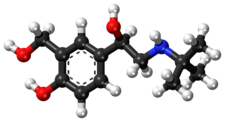Levosalbutamol
 | |
 | |
| Clinical data | |
|---|---|
| Trade names | Xopenex, other |
| Other names | evalbuterol |
| AHFS/Drugs.com | International Drug Names |
| License data |
|
| Pregnancy category |
|
| Routes of administration | By mouth (tablets), inhalational (MDI) |
| Legal status | |
| Legal status | |
| Pharmacokinetic data | |
| Metabolism | Hepatic |
| Elimination half-life | 3.3–4 hours |
| Excretion | Urinary |
| Identifiers | |
| |
JSmol) | |
| |
| |
| | |
Levosalbutamol, also known as levalbuterol, is a short-acting β2 adrenergic receptor agonist used in the treatment of asthma and chronic obstructive pulmonary disease (COPD). Evidence is inconclusive regarding the efficacy of levosalbutamol versus salbutamol or salbutamol-levosalbutamol combinations, though levosalbutamol is believed to have a better safety profile due to its more selective binding to β2 receptors (primarily in the lungs) versus β1 (primarily in heart muscle).[2][3]
The drug is the (R)-(−)-enantiomer of its prototype drug salbutamol. It is available in some countries in generic formulations from pharmaceutical companies including Cipla, Teva, and Dey, among others.
Medical use
Levosalbutamol's
Comparison to salbutamol
A 2013 systematic review of the drug's use as a treatment for acute asthma found that it "was not superior to albuterol regarding efficacy and safety in subjects with acute asthma." The review concluded: "We suggest that levalbuterol should not be used over albuterol for acute asthma."[2] Levalbuterol is notably more costly.[4][5]
Adverse effects
Generally, levosalbutamol is well tolerated. Common mild side-effects include an elevated heart rate, muscle cramps, and gastric upset (including heartburn and diarrhea).[6]
Symptoms of overdose in particular include: collapse into a
Rarer side effects may indicate a dangerous allergic reaction. These include: paradoxical
Pharmacology
Mechanism of action
Activation of β2 adrenergic
Levosalbutamol relaxes the smooth muscles of all airways, from the
While it is recognized that β2 adrenergic receptors are the predominant receptors on bronchial smooth muscle, data indicate that there are beta receptors in the human heart, 10–50% of which are β2 adrenergic receptors. The precise function of these receptors has not been established. However, all β adrenergic agonist drugs can produce a significant
Approval and names
Levosalbutamol is the
Levalbuterol was approved in the United States as a solution to be used with a nebulizer device in March 1999[7] and in March 2015 became available in a formulation with a metered-dose inhaler under the trade name Xopenex HFA (levalbuterol tartrate inhalation aerosol).[8]
See also
- Salbutamol — the racemic mixture containing both (R)-(−)- and (S)-(+)-enantiomers
References
- FDA. Retrieved 22 Oct 2023.
- ^ PMID 23207739.
- S2CID 11566782.
- PMID 16291438.
- PMID 12970057.
- ^ a b c American Society of Health-System Pharmacists (1 September 2010). "Levalbuterol Oral Inhalation". MedlinePlus. Bethesda, Maryland: U.S. National Library of Medicine, National Institutes of Health. Retrieved 7 January 2015.
- ^ "US label: levalbuterol hydrochloride Inhalation Solution" (PDF). FDA. January 2015. For updates and past labels, see FDA index page for NDA 020837.
- ^ "US label: levalbuterol tartrate inhalation aerosol" (PDF). FDA. February 2017. For updates and past labels, see FDA index page for NDA 021730.
External links
- "Levalbuterol". Drug Information Portal. U.S. National Library of Medicine.
